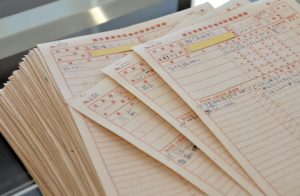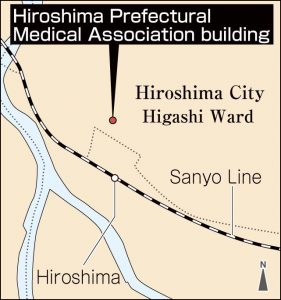Striving to fill voids in Hiroshima, evidence of victims remains—Hiroshima Prefectural Medical Association opens new exhibit for communicating A-bombing tragedy through medical records
Aug. 4, 2022
Lack of information at time leads to changes in cause-of-death descriptions
by Junji Akechi, Staff Writer
On August 4, the Hiroshima Prefectural Medical Association initiated a new “A-bombing Records Exhibit” in the first-floor lobby of the Hiroshima Prefectural Medical Association building, located in the city’s Higashi Ward. The exhibit is designed for the display of medical records related to the atomic bombing, including medical charts of patients examined immediately after the bombing by physicians. One year ago, the association called on its members to provide medical records related to relief activities that were undertaken in Hiroshima Prefecture immediately after the atomic bombing and has been collecting related information since then. The records are now available to the public free of charge each weekday from 9:00 a.m. to 5:00 p.m., with the aim of broadening public awareness of the devastation caused by the atomic bombing from the perspective of the medical community.
Among the items the prefectural medical association has collected and now exhibits is a huge volume of medical charts, dated between 1912 and 1951, that was left behind by Ichiso Takiguchi, a physician in private practice from present-day Shobara City who died in 1972 at the age of 74. The medical charts Mr. Takiguchi archived include a description of one patient who had been diagnosed with diseases accompanied by diarrhea, such as “dysentery” and “acute gastroenteritis,” in the period following the atomic bombing. According to the chart, the patient died days later.
At the time little was known about effects from the atomic bombing or radiation. The medical association is of the belief that diagnoses after the bombing included cases of acute effects caused by exposure to radiation from the bombing. The association is now proceeding with further analysis of the medical records. Takashi Takiguchi, 80, Ichiso’s grandson and a physician living in Hiroshima’s Naka Ward who donated the medical charts, said, “I preserved the records in the belief that it was my mission to pass them on to future generations. It would please me if the records could shed new light on the reality of exposure to A-bomb radiation.”
Other displayed items include death certificates that were written between August 6 and September 16, 1945, by Fuyuki Ban, a physician in private practice from Hiroshima’s present-day Asaminami Ward who died in 1967 at the age of 72. The records include cause-of-death descriptions that changed from “death from war wounds” and the like immediately after the atomic bombing to “injuries from radiation exposure” and so on starting in September. The medical association is now engaged in the compilation of videos of testimonies by physicians who experienced the atomic bombing and plans to show that information as soon as the work wraps up.
Last August, the medical association for the first time asked all of its approximately 6,900 members whether they were in possession of information related to the atomic bombing, in an attempt to prevent the scattering and loss of valuable medical records conveying the inhumanity of the atomic bombing and the hardships experienced by physicians and other medical workers amid the devastation. There were twelve instances of contact from the members, including information that led to the exhibited materials being collected.
Makoto Matsumura, chair of the medical association, hopes that members of the public “can come into contact with the reality of the atomic bombing as seen from the perspective of physicians, especially now, a time in which the world faces increased risk of nuclear weapons’ use.”
(Originally published on August 4, 2022)









